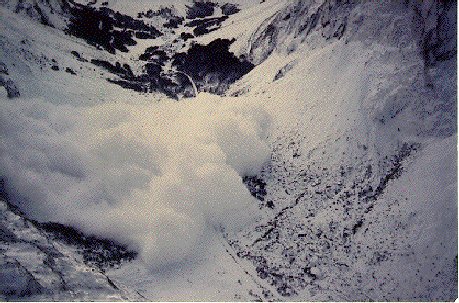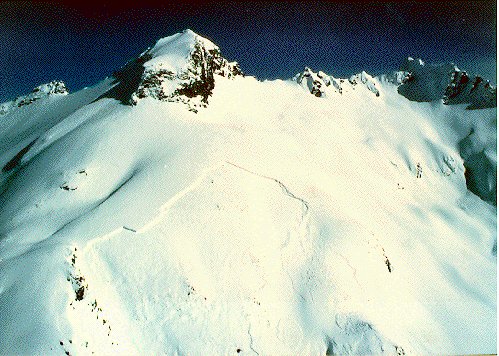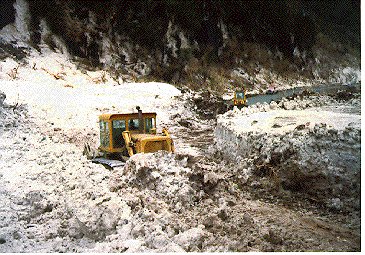
Large powder avalanche crossing Milford Highway, New Zealand. Sections of the highway along the valley floor are just visible on either side of the powder cloud.
Avalanches delay travellers and often cause damage to property. The cost of highway closures, avalanche defense structures and avalanche control can be high. For example in western Canada the annual bill for operational control and forecasting is about $10 million.

Large powder avalanche crossing Milford Highway, New Zealand. Sections of the highway along the valley floor are just visible on either side of the powder cloud.
Accurate prediction of the timing of snow avalanche activity is problematic. Most destructive avalanche cycles are caused by sustained heavy snowfall, but it is difficult to accurately define the evolution of spatial and temporal properties of snowpacks. The problem is particularly difficult in maritime regions where mid-winter rain may cause rapid changes in snow texture and strength. To address these problems we have made concurrent observations of avalanche activity, snow properties and weather in the central Cascades. We collaborate closely with the avalanche technicians from the Washington State Department of Transportation at Snoqualmie Pass and the North West Weather and Avalanche Center.
The broad goal of our research is to establish laws that describe the deformation of low density, alpine snow. A major motivation for the research is to improve forecasting of avalanche release, but the study also has practical applications for solving problems such as the design of over-snow vehicles, structures in alpine regions, and snow clearing. Our objective is to establish creep laws that are realistic and yet still tractable for use in practical applications. Our approach is to parameterize the creep response of snow using easily measured (or modeled) properties such as snow density, temperature, liquid water content, grain size and type.

Crownwall at the start zone of an avalanche. The crownwall is about 1m high and 600m wide; the total amount of snow that released was ~120,000 cubic meters (~25 million kg).

Avalanche debris is typically well compacted and hard as a result of frictional heating and work hardening. Heavy equipment is needed to clear avalanche debris, which may also contain rocks and trees.
Our earlier research showed that avalanche activity usually increases dramatically a few minutes after the onset of rain (Conway and Raymond, 1993). This timing has important consequences and applications for planning avalanche control operations. This result was a surprise because the commonly held perception was that rain- induced avalanches release when the sliding layer becomes lubricated by penetrating liquid water. High resolution measurements of creep and temperature within natural snowpacks, do not show significant changes at the sliding layer at the onset of rain (Conway et al, 1996). Typically, only the upper few centimeters of the snowpack is affected (Conway and Benedict, 1994); infiltration of liquid water and related mechanical disturbances at the depth of the sliding layer usually take several hours or more. We now suspect the rain-induced alteration of properties at the surface is sufficient to increase the longitudinal stresses within the slab and cause slab failure. We are currently investigating this hypothesis using an elastic model of failure propagation. Preliminary investigations indicate slope failure at the onset of rain is more likely if the overlying slab is thin (~ 1 m or less) and stability is already close to critical.
We are also investigating the more general implication that any surface perturbation has potential to cause stress redistribution within the slab. Although a rain induced perturbation is widespread, a more local disturbance from say a skier cutting a slope may also be significant. Existing models of the effect of a skier consider only the additional gravitational stresses; we think potential disturbances of the longitudinal stress distribution may also be important and we are investigating this effect.
Our measurements have shown that thermodynamic processes acting to minimize the surface energy on a grain-scale often have a controlling influence on the bulk deformation of low density snow. Rapid deformation often occurs without increased normal loading, particularly during first wetting; metamorphic and capillary forces (in the presence of liquid water) act independently of gravity. The rate of thermodynamically induced deformation increases with temperature and measurements indicate it can increase more than three orders of magnitude with introduction of liquid water. The rate decreases rapidly as densification proceeds. Experiments designed to further quantify the deformation associated with thermodynamic processes are currently in progress.
Conway, H., C.F. Raymond, M. Funk and S. Margreth, 2003. Snow avalanches, ice avalanches and glacier surges. Encylopedia of Life Support Systems.
Hayes, P.S., L.A. Rasmussen and H. Conway, 2002 Downscaling precipitation in the central Cascades of Washington, J. Hydrometeorology, 3(3), 335-346.
Conway, H., W. Carran and A. Carran, 2002. Estimating avalanche runout on the Milford road, New Zealand. Proc. Int. Snow Sci. Workshop, Penticton, British Columbia.
Conway, H. and C. Wilbour, 1999. Evolution of snow slope stability during storms, Cold Reg. Sci. and Tech. 30, 67-77.
Marshall, H.-P., H. Conway and L. A. Rasmussen, 1999. Snow densification during rain, Cold Reg. Sci. and Tech. 30, 35-41.
Conway, H. and C. Wilbour, 1998. Why measure new snow density, precipitation and air temperature? Proc. Int. Snow Sci. Workshop, Sunriver, Oregon, 466-473.
Conway, H., 1998. Impact of surface perturbations on snow slope stability, Annals Glaciol., 26, 307-312.
Conway, H., S. Breyfogle, J.B. Johnson and C. Wilbour, 1996. Creep and failure of alpine snow: Measurements and observations. Proc. Int. Snow Sci. Workshop, Banff, BC., 107-112.
Conway, H. and R. Benedict, 1994. Infiltration of water into snow. Water Res. Res., 30 (3), 641-649.
Conway, H., and C.F. Raymond, 1993. Snow stability during rain. J. Glaciol., 39 (133), 635-642.
Conway, H. and R. Benedict, 1992. Measurements of snow temperature during rain. Proc. Int. Snow Sci. Workshop, Breckenridge, Colo., 28-36.
Conway, H., S. Breyfogle and C. Wilbour, 1988. Observations relating to
wet snow stability. Proc. Int. Snow Sci. Workshop, Whistler, BC.
211-222.